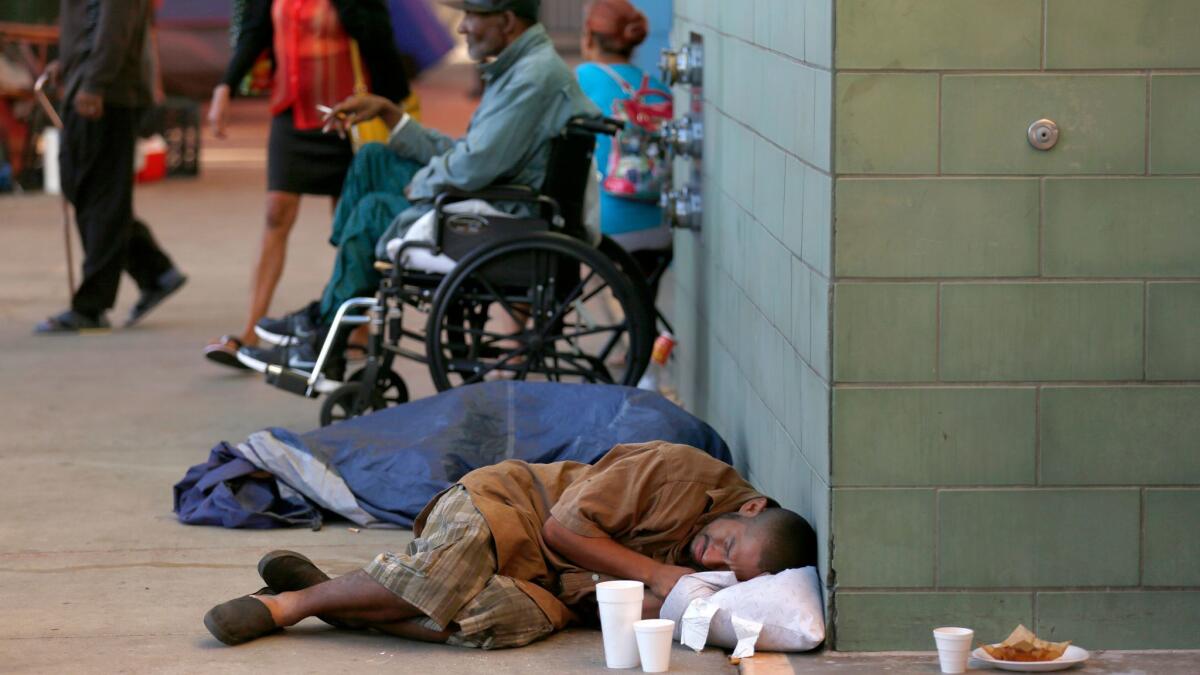L.A. County’s homeless problem is worsening despite billions from tax measures

- Share via
Los Angeles County’s homeless population is increasing faster than the supply of new housing, even with the addition of thousands of beds in the last two years and millions of dollars beginning to flow in from two ballot measures targeting the crisis, according to a long-awaited report by the region’s homelessness agency.
The report showed that officials two years ago far underestimated how much new housing would be needed when they asked city and county voters to approve the tax measures.
As a result, a $73-million annual shortfall in funding for the county’s comprehensive homelessness program could more than triple, a Times analysis of the report found.
Providing permanent housing for the county’s chronically homeless population would require more than 20,000 new units, about 5,000 more than projected two years ago, the report said.
The estimated shortage of emergency shelter and short-term rental subsidies also increased by double-digit percentages.
The report, known as the Housing Gaps Analysis, offers the latest sober assessment of the years-long surge in homelessness, marked by widespread tent encampments and rising demands for urgent action to curb the problem.
In a departure from its previous report, the Los Angeles Homeless Services Authority provided no analysis of costs associated with the needed housing in the revision released last week.
Based on estimates in the 2016 report, The Times calculated the additional costs could be about $200 million, pushing the annual shortfall to more than $270 million.
Peter Lynn, executive director of the homeless authority, said Friday that new cost figures had not been calculated, but he guessed the additional costs might be closer to $150 million, leaving a $220-million shortfall in total.
But he argued that the situation isn’t as bleak as the numbers might suggest, because the county’s multi-pronged homelessness initiative is still gearing up and the new funding is only starting to have an effect.
In creating the previous analysis, officials didn’t know what the funding would look like. But with the passage of both measures, Lynn said, “there are very serious dollars behind filling that gap.”
Now, he added, “we have a plan for deploying new permanent supportive housing through Proposition HHH and Measure H. That does give us a way forward.”
The original analysis was prepared to quantify the difference between the housing and services existing at the time and what would be needed to get all the chronically homeless off the streets and quickly restore housing for those falling into homelessness.
The report became the basis for both Proposition HHH, the homeless housing bond approved by Los Angeles city voters in 2016, and the countywide Measure H sales tax for homeless services approved last year.
Homeless advocates considered the quarter-cent sales tax to be the best approach to raising money for homelessness, but the $355 million it is expected to generate each year falls short of meeting the county program’s estimated annual cost of $428 million.
In adopting the initial Measure H budget last June, the L.A. County Board of Supervisors put off deciding how to deal with the deficit because the costs would not exceed revenue until the fourth year of the spending plan, as programs geared up.
When the supervisors review the budget in June they’ll face hard choices.
Phil Ansell, director of the county’s homeless initiative, acknowledged that the rising demand for housing and services will influence those deliberations, but he said that nothing in the report should deter the county from fulfilling its promise to voters.
“During the Measure H election we projected that Measure H would enable 45,000 families and adults to move from homelessness into permanent housing in the first five years of expanded services and that an additional 30,000 families would avoid becoming homeless,” Ansell said. “We are on track to achieve those targets.”
The 2015 homeless count, on which the previous analysis was based, put the number of people living on the streets across the county at just under 29,000.
Last year, the annual January count raised the number of unsheltered homeless people to nearly 49,000 — almost three-fourths of all homeless people.
The analysis released last week projected that more than 20,000 new units of supportive housing are needed to establish homes for chronically homeless people.
The earlier report had set the number at about 15,000, two-thirds of which the city was expected to provide with new construction funded by Proposition HHH. The rest would come from long-term rental subsidies funded by Measure H to supplement federal rent subsidies.
According to the new report, more than 6,000 new units of permanent supportive housing have been added since 2015. That includes newly constructed buildings as well as scattered placements in subsidized market rentals that are supported by traveling case managers.
The gains in housing, however, were outstripped by the rising homeless population.
The earlier report projected a reduction of 14% each year. If that had occurred, the total homeless population — including unsheltered and sheltered — would have dropped to 41,323 last year.
Instead, it climbed to nearly 59,000. The results of this year’s count will be released in the spring.
Twitter: @LATDoug
More to Read
Sign up for Essential California
The most important California stories and recommendations in your inbox every morning.
You may occasionally receive promotional content from the Los Angeles Times.











